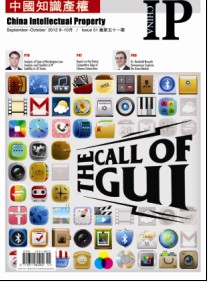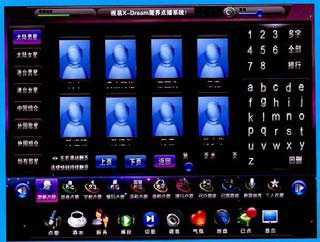
The hardware technology of electronic product s has become more sophisticated and products of the same type have similar performance and functions for consumer. Therefore, design and graphic user interface (GUI) design have played the leading roles in the competition stage for various electronic products. The reason why iPhones and iPads have won worldwide popularity mainly lies in their unique touch mode in GUI design. Companies have invested a lot of human and financial resources to make the GUIs more user-friendly and to relieve the users’ cognitive load so as to enhance the performance and competitiveness of the product.
The most common GUIs can be divided into two types: the traditional mouse and keyboard input GUI and the more common touch mode GUI. There is no substantive difference between them except for the input method. The application programs are both operated by touching icons. Touch mode GUI is widely used in portable electronic devices, such as a hand-held tablet PC, smartphone, etc. GUI is mainly composed of elements such as windows, desktops, icons and menus, while icons and its layout are the core parts. The icons themselves are highly instructive and indicative; they are symbols of the functions which can be performed by users. Special attention should be paid to ensure that though users can input programs by touching icons and operate related programs, the core of the operation is achieved by joint of supporting programs and application programs, while users’ instruction are issued in the form of clicking the icons or touching the screen.
GUIs, as a competitive tool for enterprises, reflect designers’ creative intelligence and concurrently play a crucial role in competition for consumers, and therefore should be protected by law.
The protection environment of GUI
Theoretically, it is generally believed that GUIs should be protected by the Copyright Law or by the Patent Law.
1. Copyright Law protection
Chinese Copyright Law provides protection of many subject matters, including works of fine art and compilation works. Works of fine art refer to two or three dimensional works created in lines, colors or other mediums which, when being viewed, impart aesthetic effects, such as paintings, works of calligraphy, sculptures, etc. Compilation works refer to works which are complied of certain works, fragments of works or the data or other materials not constituting a work, and selection or layout of the contents of which embody the original creation. In essence, a product’s GUI could be viewed as a work of fine art or as a compilation work.
China has neither legislation nor judicial precedent concluding that GUIs are covered by copyright protection, considered a work of fine art or a compilation work. Shenzhen TP-LINK Technologies Co., Ltd. (TP-LINK) v. Shenzhen Tenda Technology Co., Ltd (Tenda) is China’s first computer GUI copyright infringement case.
The first instance court stated that the alleged infringing GUI of the wireless router was a compilation work while the second instance court held the contrary and reversed the decision of the first instance court for three reasons. The first reason was that the function menus and buttons, as elements of GUI, indicated corresponding functions, which were parts of operational methods and were purely functional. In turn, since the Chinese copyright laws protect creative expressions, but not ideas, operational methods or mathematics concept, and therefore these operational methods were not protected under Chinese copyright laws. The second reason was that the dialog boxes, windows etc. displayed after running the related orders were common elements for designers when designing the program of routers. This intermittent display meant they could not meet the creativeness requirement for compilation works, therefore were ineligible for copyright protection. The third and final reason was the Court’s opinion that the GUI could not be considered as a compilation work because the view of the GUI as a whole (the selections, arrangements and layouts of the elements) was fairly simple and not creative enough to be distinguished from other GUIs for wireless routers. After reading the verdict delivered by the second instance court carefully, it could be concluded that the second instance court elaborated on two aspects why the alleged infringing GUI was ineligible for copyright protection: on the one hand, the constituent elements of GUI alone were not works eligible for the Copyright Law protection; on the other hand, the combination of these elements didn't meet the requirements of compilation works.
It is worth noting that the verdicts reached by the two instance courts on the GUI were totally opposite. The independent creation requirements of a work, or the ambiguity and subjective of the assessment criteria for independent creation in China lead to GUI protection under the Copyright Law must be judged according to individual circumstance. Though the assessment criteria for independent creation are common issues in copyright protection, they are more tricky issues in GUI protection. The reasons are stated below: in practice, independent creation should present a certain level of creativity, however, it is uncertain as to how high it should be. The individual elements of different GUIs are similar or even identical; the differences lie in the combinations and arrangements of the elements which should take user’s requirements into account, especially the functionality and user-friendliness. This will cause troubles when assessing independent creation.
From the draft of the third version of the Copyright Law of China, a new form of works maybe included, i.e. works of applied art. A GUI could be included into the works of applied art from its nature. However, it still lacks clarification in terms of the creativity or height of artistic sense for a GUI to be subject to copyright protection as works of applied art.
2. Patent Law protection
Both the 2006 and 2010 edition of the Guidelines for Patent Examination (Guidelines) clearly specify, “the pattern shown when the product is electrified, such as the pattern on the electronic watch dial, the pattern on the screen of the mobile phone, software interface, and so on is ineligible for patent protection for design. Furthermore, the pattern should be fixed and be perceived by the visual sense instead of intermittent displays which show under specific conditions. These provisions mean that GUI could not be protected by the Chinese Patent Law at present.”
Tracing back the history of the Guidelines, a pattern shown when the product is electrified was ineligible for Patent Law protection for the first time when the Guidelines was revised in 2006. Prior to this, many GUIs had been granted for patents. Since 2006, it has been difficult for applicants to pass preliminary examinations when applying for design patent for a GUI. For example, the examiner sent a Notification to Make Rectification to the application of a GUI design of iPhone, claiming that it was not in accordance with Article 2.4 of the Patent Law, which provides that the carrier of a design must be a product. Though the applicant had stated plenty of reasons, the examiner rejected the applicant’s claims on the ground of provisions of the Guidelines.
Of course, because there is no substantive examination, a few GUIs were still granted patents after 2006. For example, the GUI of a demand system (Shiyi X-DREAM Mojie D), whose application date was January 31st, 2008 with the application number of 200830110316.1, is still valid. Besides, the dynamic display screen of induction cooker whose application date is August 23rd, 2006 with the application number of 200630115793.8 has also been granted. As shown below:

200830110316.1

00630115793.8

200630115793.8

200630115793.8
As there is no substantive examination for design patent application, enterprises could certainly take advantage of this system to apply and acquire patents for GUIs. However, after the revision of the Patent Law in 2008, a patent protection evaluation system of design was established. Once the GUI patentee seeks administrative remedy or judicial remedy, the involved patent must undergo further examination. By then, due to the obstacles of current laws, even the GUI design could be granted patent, the protection cannot be enforced in practice.
Other countries and regions in the world, such as the United States, Japan, the European Union and South Korea, have included GUI in IP protection through legislations or amendments of laws. The United States Patent and Trademark Office (USPTO) issued Guidelines for Examination of Design Patent Application For Computer-Generated Icons, in 1996 they began to accept and grant design patents to GUIs embedded in screen displays, and in 2005 the USPTO extended the guidelines to accommodate animated GUIs In 1993, Japan Patent Office (JPO) issued Guidelines for Examination of LCD screen which stipulates that the displayed images which meet certain requirements could be granted. In 2002, JPO issued Examination LCD screen (partial designs corresponding edition), which stipulates that the provisions and requirements for partial designs are also applicable for images displayed on LCD screen. In 2006, interface design was included in the subject matter of design patent protection in Japanese Design Law. Then Design Examination Guidelines was issued in 2007. For South Korea, the Korean Intellectual Property Office (KIPO) revised the Examination Guideline for Design in 2003 to protect visual design which is consisted of GUI and icons. In 2001, EU issued “Council Regulation (EC) No. 6/2002 of 12th December 2001 on Community designs” (Council Regulation (EC) No. 6/2002) which provides legal supports to GUIs protection. There are provisions in the Euro Locarno concerning GUIs and icons. Furthermore, to the writers’ knowledge, Canada, Brazil, Australia and some other countries began to protect GUIs and icons displayed on screen as design patents in 2004, 2005 and 2010 respectively. However, animated GUIs could not be granted in the above countries.
Strategies for GUI protection
After discussing the possibilities and difficulties of GUI protection, attention should be paid to how to protect GUIs better under current laws and regulations in China.
As an interface, a GUI is composed of interface elements including windows, desktops, icons and menus; especially icons which can reflect designers’ independent creation as well as distinguish designers from one another. Therefore, when meeting certain requirements, GUI elements can be protected by the Copyright Law and the Trademark Law. A GUI designer can apply for a copyright. Creative GUI elements can be subjected to copyright registration as graphic works, or can apply for trademarks in related categories. For these GUI elements, which both meet protection requirements under the Chinese Copyright Law and the Trademark Law, applicants could apply for dual protection.
GUIs of electronic products which are in need of control from support software are not operated independently. The support software itself can be protected by the Copyright Law, and therefore enterprises should register copyrights for these support software to ensure better protection.
As for the GUI itself, it can be protected by the Copyright Law only as a work of fine art or a compilation work at present. As stated above, if protection is sought as a compilation work, the selections or arrangements should present creativity; while if one seeks protections under laws as a work of fine art, though there is not clear line at which this requirement is met, it should seek to present a certain level of creativity consistent with those levels or protection provided to other works under the law. Whether a GUI could be protected by the Copyright Law depends on individual circumstance.
(Translated by Emily Tan)
|
Copyright © 2003-2018 China Intellectual Property Magazine,All rights Reserved . www.chinaipmagazine.com 京ICP备09051062号 |
|
|



